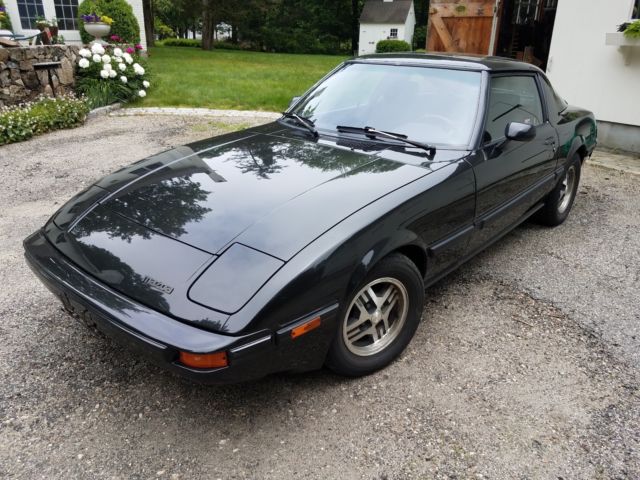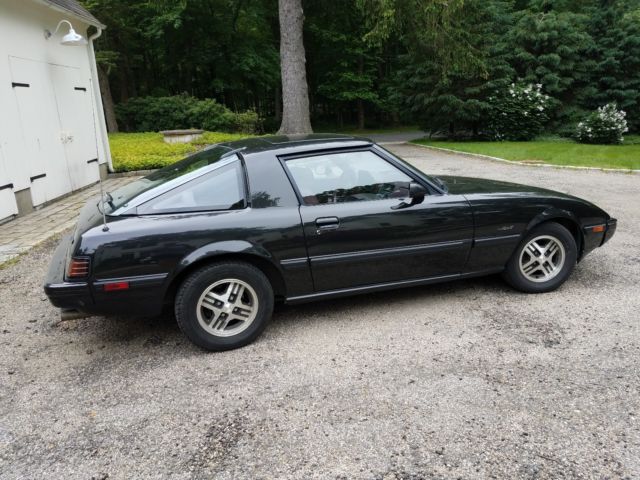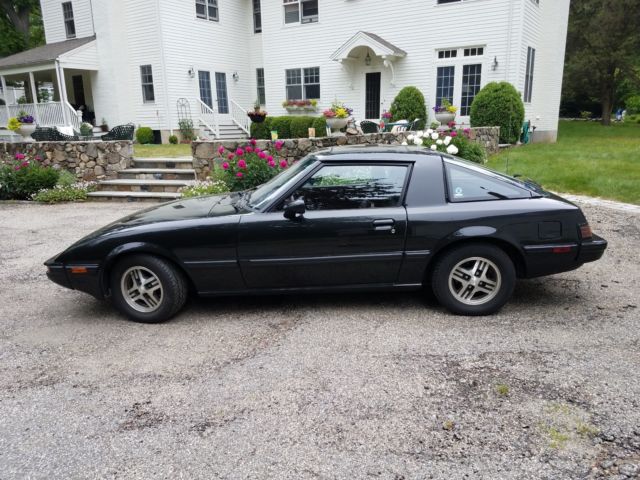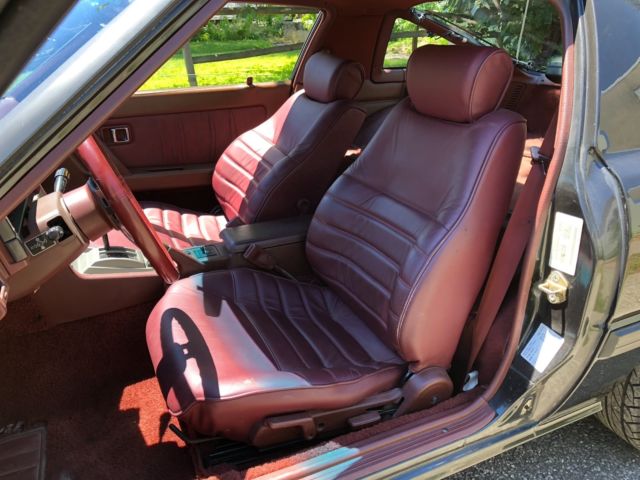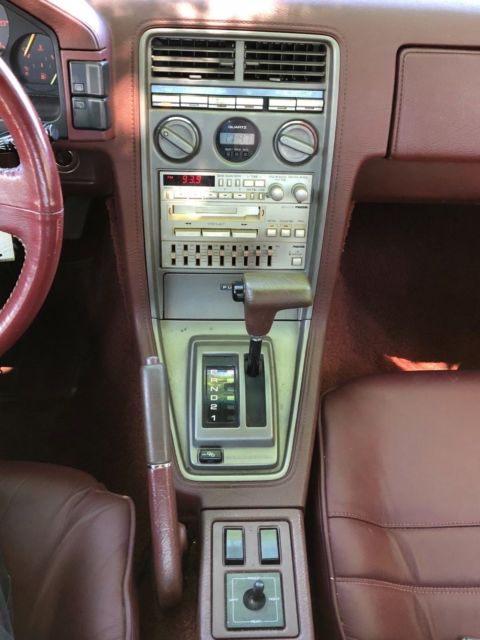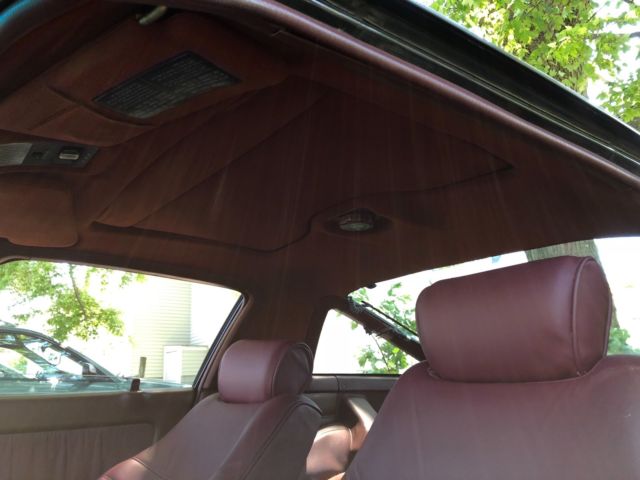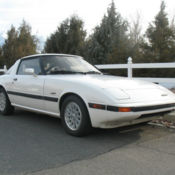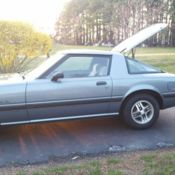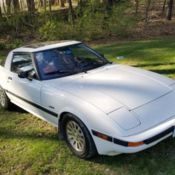1985 Mazda RX7 GSL
Technical specifications of Mazda RX-7 1985
| Price: | US $5,995.00 |
|---|---|
| Condition: | Used |
| Item location: | Charlotte, North Carolina, United States |
| Make: | Mazda |
| Model: | RX-7 |
| SubModel: | GSL |
| Year: | 1985 |
| Mileage: | 152,000 |
| VIN: | JM1FB3316F0876588 |
| Color: | Black |
| Power options: | Air Conditioning, Cruise Control, Power Windows |
| Fuel: | Gasoline |
| Transmission: | Manual |
| Drive type: | FWD |
| Interior color: | Red |
| Options: | Cassette Player, Sunroof |
| Vehicle Title: | Clear |
| You are interested? | Contact the seller! |
Description
1985 Mazda RX7 GSL for sale. Pretty much all original except for the muffler tips. These cars are getting hard to come by in this condition. This one is one of the best ones I have seen in a long time5 Speed, 12A Engine, Power Windows, Rear Defrost, Sunroof, AM/FM Radio with Equalizer
Has around 152,000 miles. The odometer reads 78,500 Someone rolled it back in the 90s. I have the carfax to show any interested buyer
I am the second owner. Purchased it last year on consignment from a dealer.
Drove it around last summer. It was a blast!!! This is my 4th Rx7. I have loved these cars since I was a kid.
Super Clean inside and out. A few minor issues. Just Inspected. Recent Oil Change
Installed a new battery in the Fall. Installed a new Antenna last week. New Fuel Pump. I did around $1000 worth of work on it over the past year. RotorSports racing in Kannapolis did all the work.
--------------------------------------------------------------------------------------------------------------------------------------------------------------
Small checklist of things I am working on. Nothing major:
- Light chipping on the front bumper
- Door Seals need to be replaced. Already purchased and will include them for the buyer
- Center console light needs to be replaced
- A couple of dings on the body. Nothing major. Paint looks great overall
- There is a little lip under the bumper. It is bent. It could probably be pulled off and re-bent back into shape. You cant really notice it unless you get up close. I think I hit a speed bump to fast.
- The windshield wipers get stuck half way up the windshield. I got them to go down all the way. Will never take it out in the rain, so this doesn't bother me. I am sure it is just a simple adjustment
- One of the back tail lights seems to be getting water in it. Probably just needs the seal replaced
- The power window switch in the console is a little loose.
- The Radio works, but the cassette deck does not. I tried Van Halen's - 1984 and was bummed when it didn't play
- The AC doesn't work. Probably needs to be charged. I never take it out when it was hot. So this doesn't bother me
- The Ashtray doesn't open
- The exhaust tips are a little rusted
---------------------------------------------------------------------------------------------------------------------------------------------------------------------------------------------------------------------------------------------------
First GenerationOverview
Also calledMazda Savanna RX-7Production1978–1985471,018 produced[1]DesignerMatasaburo Maeda (1976)Body and chassisBody style2 door coupePowertrainEngine1146 cc 12A1146 cc 12A turbo1308 cc 13B RE-EGITransmission5-speed manual4-speed manual3-speed automatic4-speed automaticDimensionsWheelbase2,420 mm (95 in)Length4,285 mm (169 in)Width1,675 mm (66 in)Height1,260 mm (50 in)Curb weight1,000–1,100 kg (2,300–2,500 lb)Series 1 (1978–1980) is commonly referred to as the "SA22C" from the first alphanumerics of the vehicle identification number. In Japan it was introduced in March 1978, replacing the Savanna RX-3, and joined Mazda's only other remaining rotary engine powered products, called the Mazda Cosmo which was a two-door luxury coupe, and the Mazda Luce luxury sedan.
The lead designer at Mazda was Matasaburo Maeda, whose son, Ikuo, would go on to design the Mazda2 and Mazda RX-8. The transition of the Savanna to a sports car appearance reflected products from other Japanese manufacturers. The advantage the RX-7 had was its minimal size and weight, and the compact rotary engine installed behind the front axle, which helped balance the front to rear weight distribution, and provide a low center of gravity.
In Japan, sales were enhanced by the fact that the RX-7 complied with Japanese Government dimension regulations, and Japanese buyers were not liable for yearly taxes for driving a larger car. The rotary engine had financial advantages to Japanese consumers in that the engine displacement remained below 1.5 liters, a significant determination when paying the Japanese annual road tax which kept the obligation affordable to most buyers while having more power than the traditional inline engines.
In May 1980, Mazda released a limited production run of special North American models known as the Leathersport Models. This package was essentially an uprated GS model with added LS badges on each B-pillar, special striping, and LS-only gold anodized wheels (with polished outer face and wheel rim). All LS editions came equipped with special LS-only full brown leather upholstery, leather-wrapped steering wheel, leather wrapped shift knob, removable sunroof, LS-specific four-speaker AM/FM stereo radio with power antenna (though listed as a six-speaker stereo, as the two rear dual voice coil speakers were counted as four speakers in total), remote power door side mirrors, and other standard GS equipment. Two primary options were also available; a three-speed JATCO 3N71B automatic transmission and air conditioning. Other GS options such as cassette tape deck, splash guards, padded center console armrest and others could be added by the dealer. The LS model was only ever available in three different exterior colors: Aurora White, Brilliant Black, and Solar Gold. No official production records are known to exist or to have been released. This series of RX-7 had exposed steel bumpers and a high-mounted indentation-located license plate, called by Werner Buhrer of Road & Track magazine a "Baroque depression."
Mazda RX-7 Series 2 (US)
The Series 2 (1981–1983) had integrated plastic-covered bumpers, wide black rubber body side moldings, wraparound taillights and updated engine control components. While marginally longer overall, the new model was 135 lb (61 kg) lighter in federalized trim.[3] The four-speed manual option was dropped for 1981 as well, while the gas tank grew larger and the dashboard was redesigned, including a shorter gear stick mounted closer to the driver.[3] In 1983, the 130 mph speedometer returned for the RX-7. The GSL package provided optional four-wheel disc brakes, front ventilated (Australian model) and clutch-type rear limited slip differential (LSD). Known as the "FB" in North America after the US Department of Transportation mandated 17 digit Vehicle Identification Number changeover. For various other markets worldwide, the 1981–1985 RX-7 retained the 'SA22C' VIN prefix. In the UK, the 1978–1980 series 1 cars carried the SA code on the vehicle VIN but all later cars (1981–1983 series 2 & 1984–1985 series 3) carried the FB code and these first generation RX-7's are known as the "FB". The license-plate surround looks much like Buhrer's "Styling Impressions."
In Europe, the FB was mainly noticed for having received a power increase from the 105 PS (77 kW) of the SA22; the 1981 RX-7 now had 115 PS (85 kW) on tap. European market cars also received four-wheel disc brakes as standard.[4]
1984–1985 Mazda RX-7 (Series 3; Australia)
The Series 3 (1984–1985) featured an updated lower front fascia. North American models received a different instrument cluster. GSL package was continued into this series, but Mazda introduced the GSL-SE sub-model. The GSL-SE had a fuel-injected 1.3 L 13B RE-EGI engine producing 135 hp (101 kW) and 135 lb⋅ft (183 N⋅m). GSL-SEs had much the same options as the GSL (clutch-type rear LSD and rear disc brakes), but the brake rotors were larger, allowing Mazda to use the more common lug nuts (versus bolts), and a new bolt pattern of 4x114.3 (4x4.5"). Also, they had upgraded suspension with stiffer springs and shocks. The external oil cooler was reintroduced, after being dropped in the 1983 model-year for the controversial "beehive" water-oil heat exchanger.
The 1984 RX-7 GSL has an estimated 29 highway miles per gallon (8.11 litres per 100 km) /19 estimated city miles per gallon (12.37 l/100 km). According to Mazda, its rotary engine, licensed by NSU-Wankel allowed the RX-7 GSL to accelerate from 0 to 50 (80 km/h) in 6.3 seconds. Kelley Blue Book, in its January–February 1984 issue, noted that a 1981 RX-7 GSL retained 93.4% of its original sticker price.
In 1985 Mazda released the RX-7 Finale in Australia. This was the last of the series and brought out in limited numbers. The Finale featured power options and a brass plaque mentioning the number the car was as well as "Last of a legend" on the plaque. The finale had special stickers and a blacked out section between the window & rear hatch.
The handling and acceleration of the car were noted to be of a high caliber for its day. This generation RX-7 had "live axle" 4-link rear suspension with Watt's linkage, a 50/50 weight ratio, and weighed under 2,500 lb (1,100 kg). It was the lightest generation of RX-7 ever produced. 12A-powered models accelerated from 0–60 mph in 9.2 s, and turned 0.779 g (7.64 m/s²) laterally on a skidpad. The 12A engine produced 100 hp (75 kW) at 6,000 rpm, allowing the car to reach speeds of over 120 miles per hour (190 km/h). Because of the smoothness inherent in the Wankel rotary engine, little vibration or harshness was experienced at high engine speeds, so a buzzer was fitted to the tachometer to warn the driver when the 7,000 rpm redline was approaching.
The 12A engine has a long thin shaped combustion chamber, having a large surface area in relation to its volume. Therefore, combustion is cool, giving few oxides of nitrogen. However, the combustion is also incomplete, so there are large amounts of partly burned hydrocarbons and carbon monoxide. The exhaust is hot enough for combustion of these to continue into the exhaust. An engine driven pump supplies air into the exhaust to complete the burn of these chemicals. This is done in the "thermal reactor" chamber where the exhaust manifold would normally be on a conventional engine. Under certain conditions, the pump injects air into the thermal reactor and at other times air is pumped through injectors into the exhaust ports. This fresh air is needed for more efficient and cleaner burning of the air/fuel mixture.
Options and models varied from country to country. The gauge layout and interior styling in the Series 3 was only changed for North American versions. Additionally, North America was the only market to have offered the first generation RX-7 with the fuel-injected 13B, model GSL-SE. Sales of the first generation RX-7 were strong, with a total of 474,565 first generation cars produced; 377,878 (nearly eighty percent) were sold in the United States alone. In 2004, Sports Car International named this car seventh on their list of Top Sports Cars of the 1970s. In 1983, the RX-7 would appear on Car and Driver magazine's Ten Best list for the first time in 20 years.
